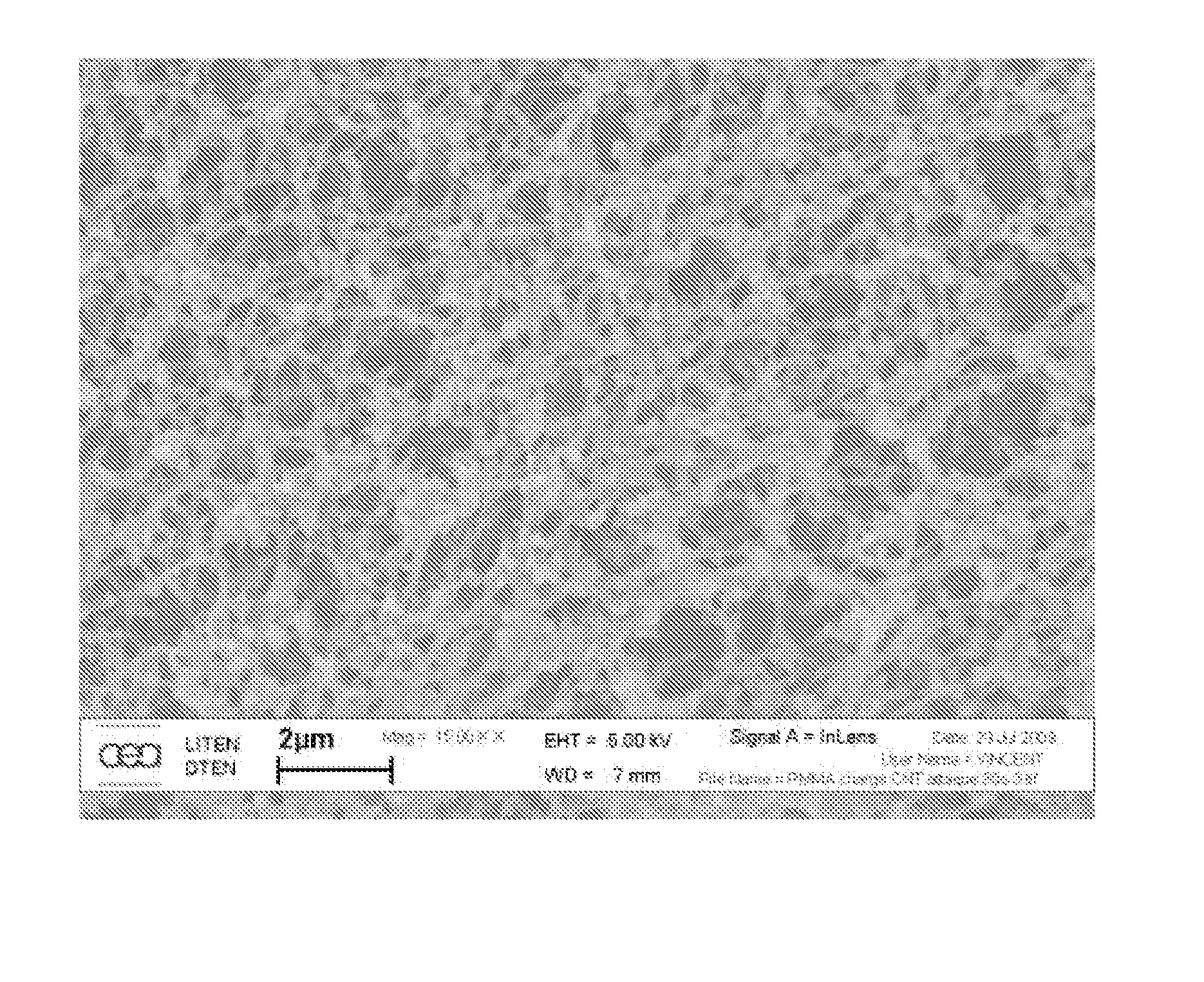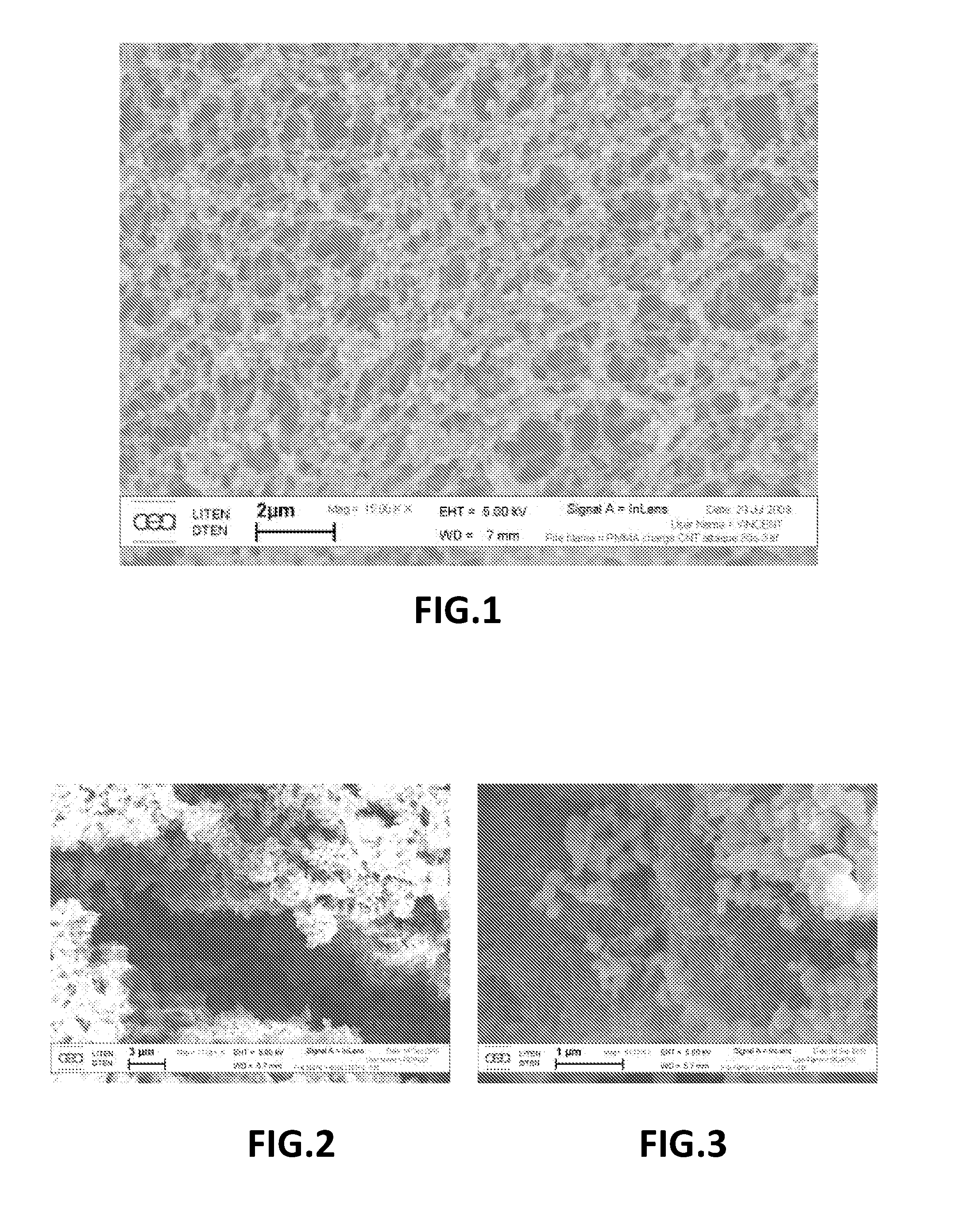Method for preparing a silicon/carbon composite material, material so prepared, and electrode, in particular negative electrode, comprising said material
a composite material and material technology, applied in the field of silicon/carbon composite materials, can solve the problems of reaching their limits in terms of performance, low reversible capacity, and increasing the demand for specifications for equipment using these batteries
- Summary
- Abstract
- Description
- Claims
- Application Information
AI Technical Summary
Benefits of technology
Problems solved by technology
Method used
Image
Examples
example 1
[0391]In this example a silicon / carbon nanotube “CNT” composite material according the invention is prepared using the method according to the invention.
[0392]The manufacture of the Si / CNT composite material according to the invention comprises 4 steps: (a) Manufacture of the CNT / Si assembly, (b) Manufacture of CNT / Si capsules, (c) Chemical vapour deposition “CVD” of silicon, (d) Heat treatment.
[0393]a) Manufacture of 120 g of Self-Assembled CNT / Si:
[0394]To manufacture 120 g of self-assembled CNT / Si, 100 g de silicon with a particle size distribution of less than 500 nm is required (the material used is commercial silicon from the S'tile® organisation), with 5 litres of deionised water, 550 ml of ethanol and 10 g of carbon nanotubes.
[0395]The carbon nanotubes used are multi-walled carbon nanotubes from the Arkema® company.
[0396]Step a) itself includes sub-steps a1) to a4).
[0397]a1) the method starts by pre-dispersing the silicon nanopowders by wetting 100 g of silicon with 500 ml of...
example 2
[0436]In this example a negative electrode is prepared with the material according to the invention prepared in example 1.
[0437]The preparation of the negative electrode with this material is achieved in two steps: a) Extrusion and refining of the electrode material; b) Spreading, drying and calendering of the negative electrode material.
[0438]a) Extrusion and Refining of the Electrode Material:
[0439]The extrusion operation is carried out in a twin-screw extruder (111) represented in FIG. 11.
[0440]This extrusion operation is carried out at ambient temperature.
[0441]First of all 100 g of material according to the invention (112) is taken, prepared in example 1, in a first metering feeder (or hopper) (113) with which the extruder is equipped (111).
[0442]The fine powders such as 20 g of vapour-grown carbon fibres “VGCF” (conductive material), 21 g of alginate or of Carboxymethyl Cellulose (“CMC”) (as binders), are dry-mixed mechanically and placed (114) in the second metered feeder (11...
example 3
[0451]The negative electrode prepared in example 2 is then tested in a lithium metal battery (half-cell test) of the button battery type.
[0452]Each button battery is mounted in strict accordance with the same protocol.
[0453]The following are therefore stacked from the bottom of the battery base, as shown in FIG. 8:[0454]a negative electrode according to the invention (16 mm diameter, 150 μm thickness) (1) deposited on a copper (or nickel) disk acting as a current collector;[0455]150 μL of LPF6 salt-based electrolyte liquid, at a concentration of 1 mol / L. in solution in a mixture of 1 / 1 by mass of ethylene carbonate and dimethyl carbonate, but any other non-aqueous liquid electrolyte known in the technique may be used;[0456]the electrolyte is soaked into a separator which is a polyolefin microporous membrane, more precisely a microporous membrane made of Celgard polypropylene (2)Ø16.5 mm;[0457]a positive electrode (3) made up of a disk of diameter 14 mm made of lithium metal;[0458]a ...
PUM
| Property | Measurement | Unit |
|---|---|---|
| porosity | aaaaa | aaaaa |
| density | aaaaa | aaaaa |
| thickness | aaaaa | aaaaa |
Abstract
Description
Claims
Application Information
 Login to View More
Login to View More - R&D
- Intellectual Property
- Life Sciences
- Materials
- Tech Scout
- Unparalleled Data Quality
- Higher Quality Content
- 60% Fewer Hallucinations
Browse by: Latest US Patents, China's latest patents, Technical Efficacy Thesaurus, Application Domain, Technology Topic, Popular Technical Reports.
© 2025 PatSnap. All rights reserved.Legal|Privacy policy|Modern Slavery Act Transparency Statement|Sitemap|About US| Contact US: help@patsnap.com



